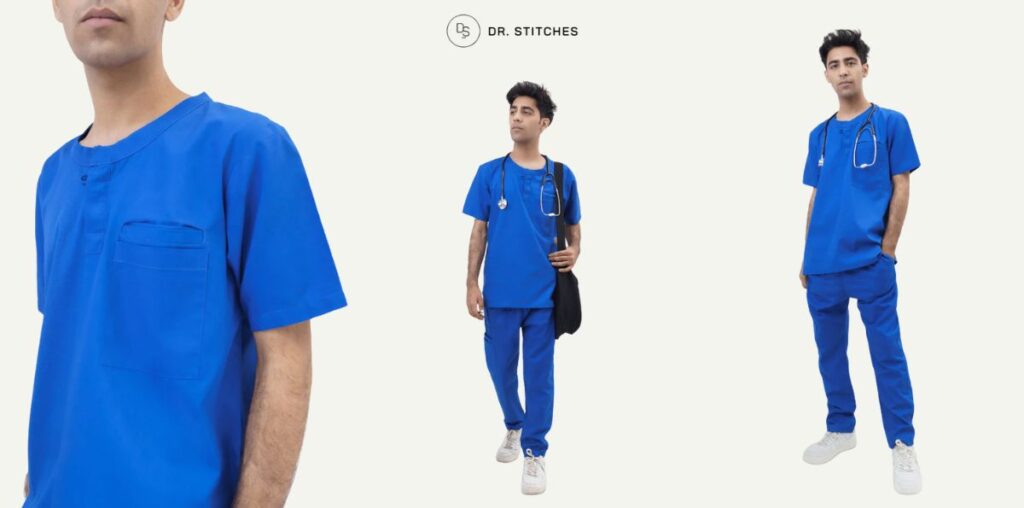Scrubs are a staple uniform in the healthcare field, but not all scrubs are created equal—especially when it comes to different medical professions. Dentists and surgeons, while both operating in sterile environments, have vastly different daily responsibilities, movement requirements, and practical needs. That’s where tailored male scrubs design steps in to meet the specific demands of each role. Choosing the right scrubs isn’t just about looking good—it’s about feeling comfortable, maintaining hygiene, ensuring functionality, and enhancing overall performance. In this article, we explore the key differences between mens scrubs for dentists vs. surgeons, and how thoughtful design helps support each of these healthcare heroes in their day-to-day duties.
Understanding the Needs: Dentists vs. Surgeons
Dentists typically perform procedures in seated positions, often in close proximity to the patient’s face. They require freedom of arm movement, stain resistance, and the ability to stay cool under the pressure of long treatments. Meanwhile, surgeons spend hours in the operating room, often standing for extended periods in high-stress, sterile environments. Their scrubs must prioritize ease of movement, breathability, and maximum hygiene compliance.
These distinct working conditions demand specific features in scrub design—starting from fabric choice to functionality and fit.
Fit and Mobility: Movement is Key
When it comes to male scrubs design, comfort and flexibility take precedence. For dentists, scrubs that offer stretch around the shoulders and back are essential due to frequent leaning and reaching into the oral cavity. Modern scrub tops with raglan sleeves or side panel inserts can offer more freedom of movement without riding up or restricting motion.
On the other hand, surgeons need scrubs that won’t feel restrictive during long hours of surgery. Looser-fitting tops and pants made from breathable, non-stick fabrics are preferred. They must allow full range of motion while minimizing heat buildup under bright surgical lights and protective gear. Tailored jogger pants with drawstrings or elastic waists ensure comfort during these extended procedures.
Fabric Choice: Function Over Fashion
Dentists are prone to getting splashes of fluids and chemicals, so stain-resistant and easy-to-clean fabrics are a priority. Lightweight cotton-polyester blends or synthetic fabrics with moisture-wicking technology help keep them cool and dry while preventing discoloration from dental materials like fluoride or polishing paste.
Surgeons, however, need fabrics that can withstand multiple autoclave cycles or high-temperature laundering to meet hygiene standards. Antimicrobial properties and fluid-repellent finishes are crucial. Breathable, high-performance blends are common in male scrubs design for operating rooms, where sterility is non-negotiable.
Pocket Placement and Utility
Dentists need strategically placed pockets for pens, small instruments, and gloves. Chest and side pockets with reinforced stitching allow quick access without compromising mobility. Zippered compartments or hidden pockets can add a clean and professional appearance without sacrificing utility.
Surgeons often rely less on carrying tools within their scrubs during procedures, since instruments are typically laid out in the sterile field. However, they may still need a couple of deep pockets before and after surgeries to carry essentials like IDs, notepads, or a mobile phone. Scrubs with minimal but functional pocket placement are ideal to avoid clutter and maintain a sterile appearance.
Color Coding and Style Preference
While some hospitals and clinics have strict color codes, many allow professionals to choose their scrub colors. Dentists often lean toward lighter shades like white, gray, or dental blue—colors that reflect cleanliness and calmness for patients. These shades also help hide toothpaste or polish stains better.
Surgeons, however, are often seen in deeper colors like green or navy, which reduce glare from operating room lights and are better at concealing blood or fluid stains. This color contrast also helps reduce eye strain, especially during long hours of surgery.
Regardless of profession, modern male scrubs design now embraces subtle style elements—like contrast stitching, tapered cuts, and even slight V-necks—to create a look that is both polished and functional.
Breathability and Heat Management
Dentists often work in smaller, less ventilated spaces compared to operating rooms. Therefore, their scrubs need enhanced breathability. Mesh panels, moisture-wicking liners, and ventilated back panels help dentists remain cool even during busy patient schedules.
Surgeons face a different challenge: operating rooms are often kept at cooler temperatures to inhibit bacterial growth, but wearing surgical gowns and gloves over scrubs can still cause discomfort. Hence, lightweight and thermoregulating scrub materials are essential to keep body temperature balanced.
Durability and Wash Cycles
Surgeons’ scrubs face heavier wash cycles due to stringent sterilization protocols. These garments must resist fading, shrinking, and fabric breakdown. Premium scrubs with triple-stitched seams and high-quality fabric blends can withstand repeated laundering without losing shape or color.
Dentists’ scrubs also go through frequent washing but can focus more on stain resistance and comfort. Easy-care materials that retain softness and structure are a top choice for dental professionals who work long shifts.
Conclusion
The difference between mens scrubs for dentists vs. surgeons goes beyond style—it’s about tailoring form to function. Each profession within healthcare has its own rhythm, pace, and demands. A one-size-fits-all approach simply doesn’t cut it anymore.
Today’s innovations in male scrubs design are helping professionals move seamlessly through their day—whether they’re filling cavities or performing life-saving surgeries. By choosing scrubs that match the specific requirements of your role, you’re not just enhancing comfort and functionality, you’re also presenting yourself as a confident, capable, and well-prepared professional.
Because in healthcare, the right uniform doesn’t just serve the body—it supports the mission.



